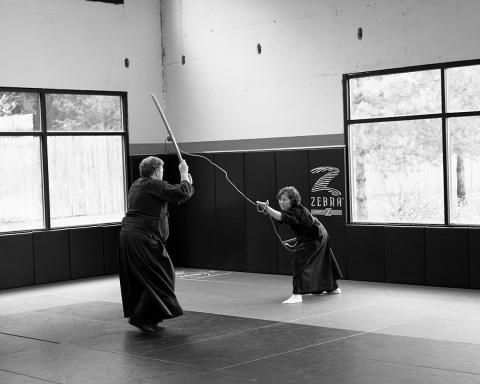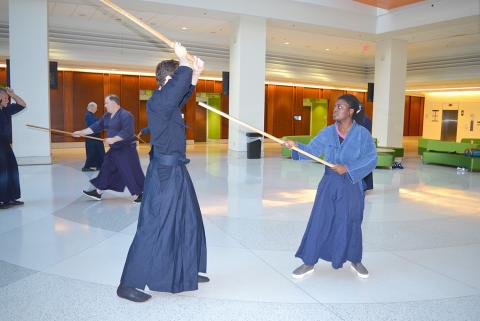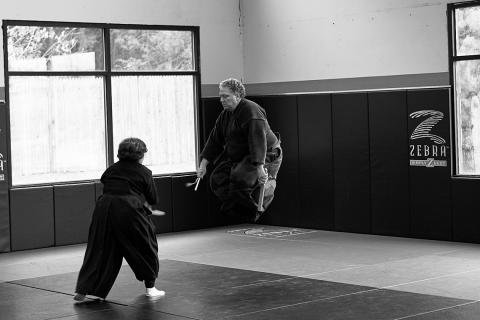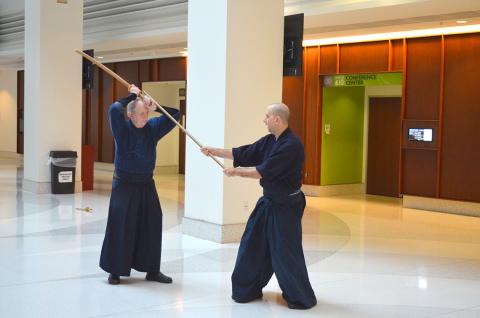Out of the Office
NIH’ers Trade Science for Swords on the Weekends

Photo: mark raugas
Ever wonder what your fellow NIH colleagues are up to on the weekends? It turns out some return to the Bethesda campus on Saturdays and Sundays—but not to work. A small group of NIH’ers in the Kenjutsu Club can be found training with classic Japanese weapons every weekend in Bldg. 35.
Kenjutsu is an umbrella term for the various schools of ancient Japanese swordsmanship. The NIH club alternates between practicing Shindō Musō-ryū, or the stick art, and Yagyū Shinkage-ryū, the sword art. No, the club does not use real swords in their practice; instead, they opt for a leather-covered bamboo training weapon. The club does train with the actual stick, or jo, when practicing Shindō Musō-ryū.
The Kenjutsu Club was formed in 1998 by staff at NIH: David Samuels and Bradley Duker, and included Robert Deppe—who is still a member. All were training with current instructor Dr. David Hall in Rockville until establishing a formal club with the NIH Recreation & Welfare Association (R&W).

Photo: connie noguchi
Shortly after the club was founded, Dr. Connie Noguchi of the National Institute of Diabetes and Digestive and Kidney Diseases joined to gain weapons experience while working on her third black belt in karate. Twenty-five years later, Noguchi now organizes the club of 23 members.
Noguchi describes Kenjutsu as a subtle art that requires both physical and mental strength. Each discipline revolves around partner work and is choreographed, allowing participants to concentrate on specific aspects of the techniques while protecting each other.
“It’s special in the way that you have to have complete trust in your partner and you get to focus on what’s immediately on hand,” Noguchi explains. “Once you bow in, for the next two hours that’s all you’re thinking about.”

Photo: mark raugas
John Buckley was working as a biomedical contractor with the National Cancer Institute in 1998 when he started looking for local groups and instructors practicing sword styles. It wasn’t until he asked around on local boards that he found out about the club.
“The guy who ran the board said, ‘the only person I know of who is credentialed is someone who lives in Rockville, Maryland.’ And I thought to myself, ‘I live in Rockville, Maryland,’” recounts Buckley. “And then he says, ‘Yeah, he has a club at the National Institutes of Health.’ And I said, ‘Oh the place that I work?’”
With the stars aligned, Buckley attended a session and was impressed by Hall’s knowledge and talent.
“I fell into it by sheer happenstance,” Buckley says. “It’s been worthwhile enough that I’ve stayed here doing this for 25 years—almost half my life.”

During the Covid-19 pandemic, National Heart, Lung, and Blood Institute Senior Investigator Dr. Justin Taraska was looking to get more involved with the NIH community. Taraska had been practicing aikido for years, and the Kenjutsu club description caught his eye. He joined with no expectations and found a welcoming group of like-minded individuals.
“For scientists, I think it’s a really meaningful activity because it involves a lot of attention, careful practice, a spirit of exploration and discovery, and it has a very developed mentorship system,” explains Taraska. “I really think that scientists mesh with that style of learning and development.”
The club trains on Saturdays and Sundays in the Bldg. 35 atrium. If you are interested in joining the club—no experience is necessary—contact Noguchi at connien@niddk.nih.gov.
View the entire list of clubs offered at NIH at govemployee.com/nih/rw-services-membership/clubs-organizations/.
